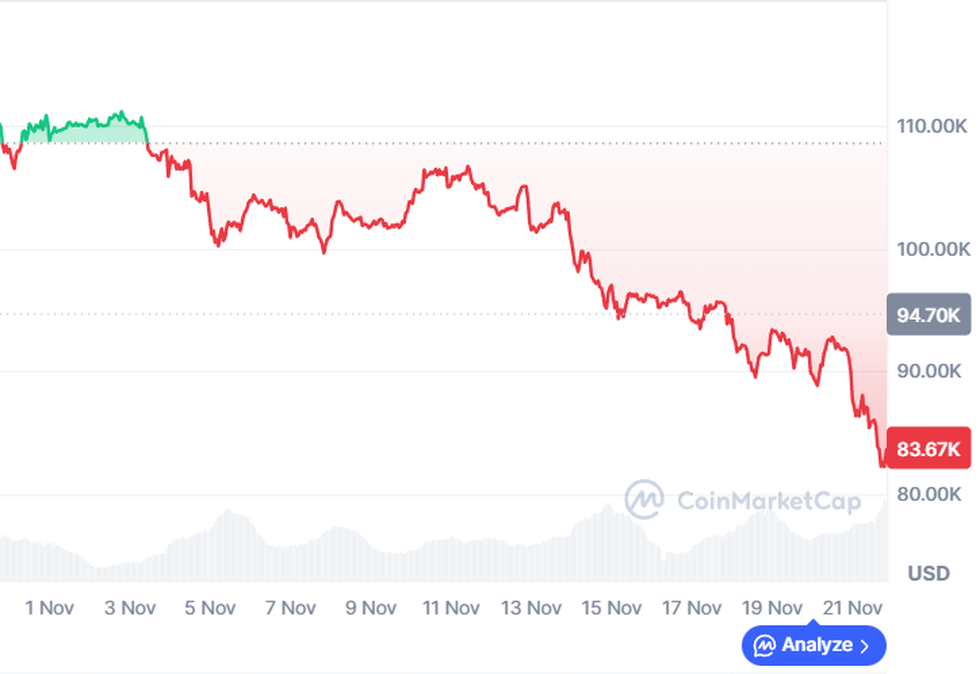If October once brought hope for a new record, November is going down in crypto market history in a gray color.
The numbers on the electronic board are telling a story not for the faint-hearted: Bitcoin (BTC) plummeted, breaking through the $82,000 mark, the total market capitalization evaporated from the $3,000 billion mark, and fear pervaded all trading decisions.
The billion-dollar "slip"
In just the past 24 hours, the digital financial market has witnessed a brutal purge. Data from international exchanges updated until the evening of November 21 (Vietnam time) shows that bitcoin - the "big brother" of the digital currency village - is experiencing its worst trading month since the chain collapse of the Terra-LUNA ecosystem and FTX exchange in 2022.
From the level of nearly 92,000 USD recovered not long ago, Bitcoin has suddenly fallen to the area of 81,629 USD, marking a decrease of up to 23% in November alone. This is the deepest monthly decrease in the past 3 years. This fall not only stunned the "peak-hopping" investors but also dragged down the entire market.
The total crypto market capitalization officially broke the $3 trillion mark for the first time since April this year - a number that speaks to the severity of this correction.

Bitcoin is on track for its worst month since a series of corporate collapses rocked the entire cryptocurrency sector in 2022 (Photo: MarketWatch).
Ether (ETH), the second largest cryptocurrency, could not escape the spiral when it lost the $2,700 mark, down 7.6%. Other altcoins such as solana, BNB or XRP also recorded double-digit drops, causing the accounts of many individual investors to "evaporate" quickly.
Notably, the selling pressure is not just a natural correction. Data from CoinGlass shows that a “storm” of liquidations has swept through the market. On October 10 alone, $19 billion worth of leveraged orders were wiped out. And in the past 24 hours alone, another $2 billion has been forced to be liquidated by exchanges.
As prices fell, highly leveraged long orders hit their stop-loss levels, triggering a wave of automatic sell-offs that pushed prices further down.
Root causes: From macro to "sharks" dumping goods
To explain this terrible decline, financial analysts pointed to the resonance of many negative factors, creating a "perfect storm".
First, pressure from the macro economy .
While markets had been hoping for monetary easing, the latest data has cast doubt. US stocks, crypto’s “companion” in recent growth, are losing momentum. The hype around artificial intelligence (AI) and Nvidia (NVDA) stock has cooled amid concerns about lofty valuations.
More importantly, the possibility of the US Federal Reserve (Fed) cutting interest rates in December is becoming dim. When interest rates are anchored high, money tends to withdraw from risky assets like Bitcoin to take refuge in government bonds or cash.
Second, the withdrawal of institutional money.
The actions of the “big guys” (whales) and institutional investment funds are sending an alarming signal. The group of 12 bitcoin ETFs listed in the US recorded a record net withdrawal of $903 million on November 20 alone. This was the second-largest capital withdrawal day since these products launched in early 2024. As the Wall Street capital flow, which was considered a solid foundation for the price increase at the beginning of the year, began to reverse, market sentiment immediately became fragile.
Third, selling pressure from long-term holders.
One piece of information that has caused a stir in the community is the move of the digital wallet named Owen Gunden. This wallet, which has been holding bitcoin since 2011 (when bitcoin was still in its infancy), has started dumping goods since the end of October with a total value of up to 1.3 billion USD. The fact that early investors decided to take profits at this time is considered a negative signal for the short-term outlook.
Pratik Kala, portfolio manager at Apollo Crypto, an investment fund in Australia, said: “Market sentiment is very weak. There seems to be widespread forced selling and no one is sure how long this will last.”

BTC is down 23% this month and more than 30% from its October peak (Illustration: Decrypto).
MicroStrategy and the line between life and death
One extremely interesting and risky aspect of corporate finance in this crash involves MicroStrategy – the public company that holds a huge amount of bitcoin under the leadership of billionaire Michael Saylor.
Tony Sycamore, an analyst at IG Australia, offered a sharp insight: The market may be deliberately “testing the threshold” of Michael Saylor’s leveraged bitcoin hoarding strategy.
The problem is that MicroStrategy has borrowed heavily to buy bitcoin. If the price of BTC continues to fall toward the company’s breakeven level, margin calls could be triggered, forcing the company to sell assets or raise more capital amid difficulties in securing collateral, setting off a new downward spiral. Strategy’s stock fell 5% in trading on November 20, and its enterprise value-to-bitcoin-holdings (mNAV) ratio fell to an alarming 1.2 times.
Analysts at JPMorgan Chase & Co. even warned that Strategy could be removed from key indexes like MSCI USA and Nasdaq 100 if the situation does not improve by January 15.
Future scenario: $200,000 or $58,000?
Amid the gloomy picture, investors are deeply divided on where bitcoin goes next.
Technical analysis is sending out some not-so-positive signals. The “Death Cross” pattern, where the 50-day moving average crosses below the 200-day, has appeared on the daily chart. This is a classic technical indicator that signals a long-term downtrend.
Many experts, including analysts from CoinGape and 10x Research, warn that if the $80,000-$82,000 support zone is broken, bitcoin could very well slide to its “real value” zone around $58,000 (which coincides with the 200-week moving average). The Fear & Greed Index has now fallen to 11, the “Extreme Fear” zone, its lowest level since the 2022 bottom.

Bitcoin's "fiery red" November (Photo: CoinMarketCap).
However, not everyone sees black. Peter Brandt, a legendary veteran trader with many accurate predictions of bitcoin's peaks and troughs in the past, has an interesting contrarian perspective.
While Brandt acknowledges the possibility that bitcoin could fall to $58,000 in the short term, he sees this as the “best thing” that could happen. According to him, the market needs a complete “shakeout” of weak investors and excessive leverage positions to gain momentum for a truly sustainable growth cycle.
Based on the 4-year cycle and historical data, Peter Brandt maintains his bold prediction: Bitcoin will hit $200,000 in the next bull cycle, expected to peak around Q3 2029. He revealed that he still holds 40% of his portfolio in bitcoin and is undeterred by the current volatility.
The cryptocurrency market is going through its most severe cleanup in two years. The combination of macro pressure, institutional withdrawal and retail panic is creating a “perfect storm”.
For investors, this is a time that requires more alertness than ever. Bottom fishing at this time has the potential to be extremely risky when the downtrend shows no signs of ending. However, history also proves that life-changing opportunities are often born in the most pessimistic times. Closely monitoring important support levels (75,000 USD and 58,000 USD) and managing portfolio risks will be the key to surviving this "dark November".
Source: https://dantri.com.vn/kinh-doanh/thang-den-toi-cua-bitcoin-bong-ma-2022-hien-ve-va-kich-ban-gia-58000-usd-20251121203206576.htm














































































































Comment (0)